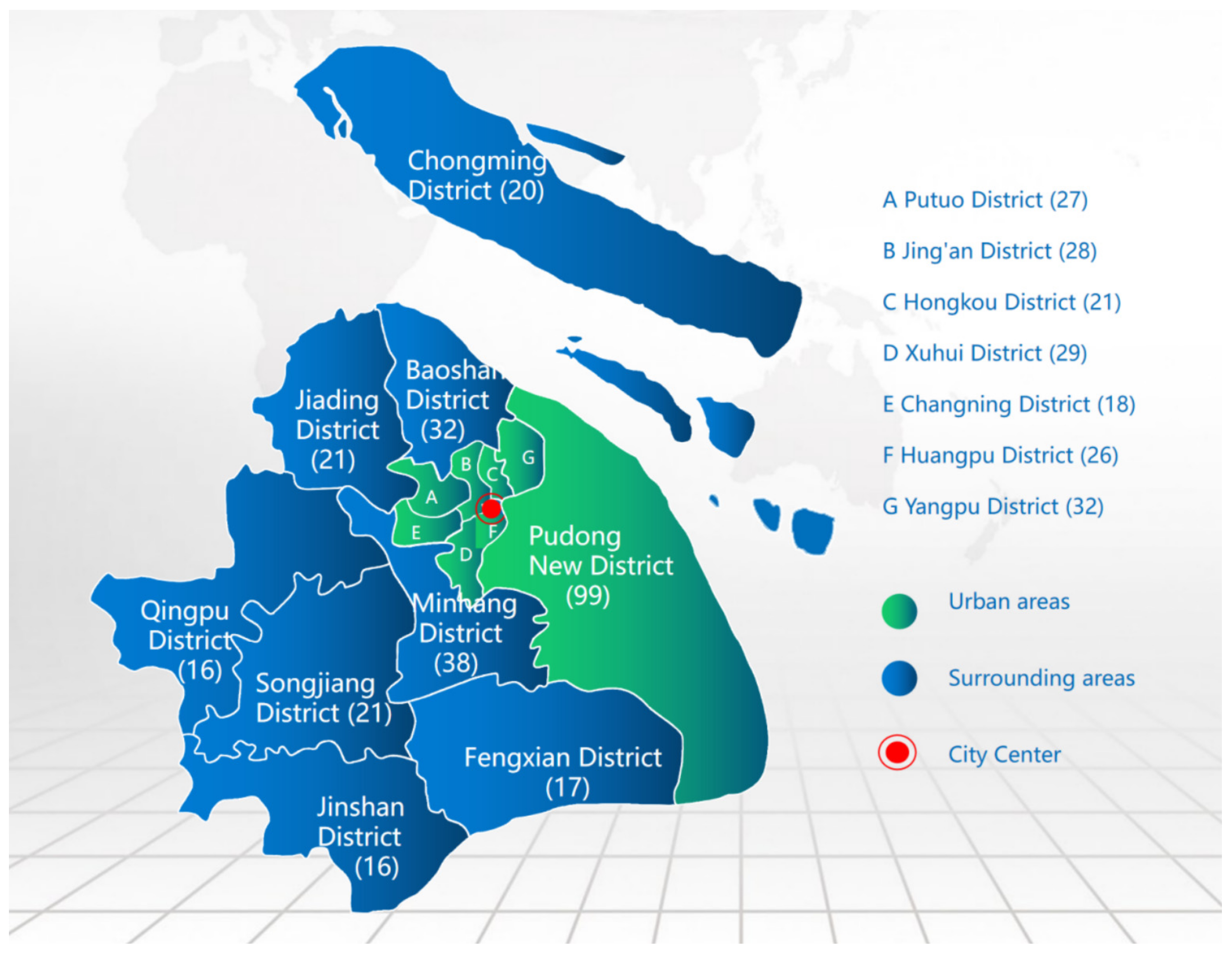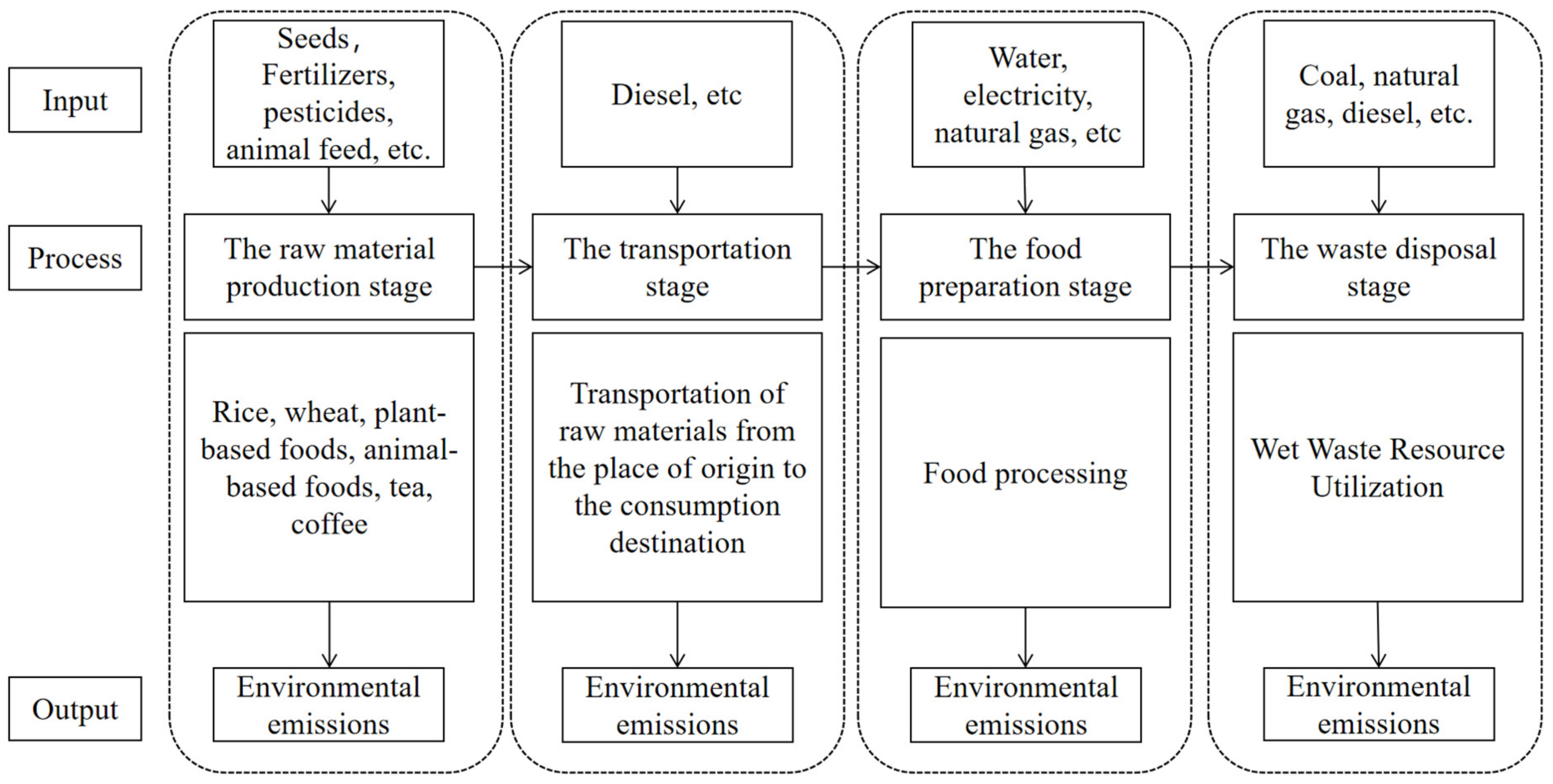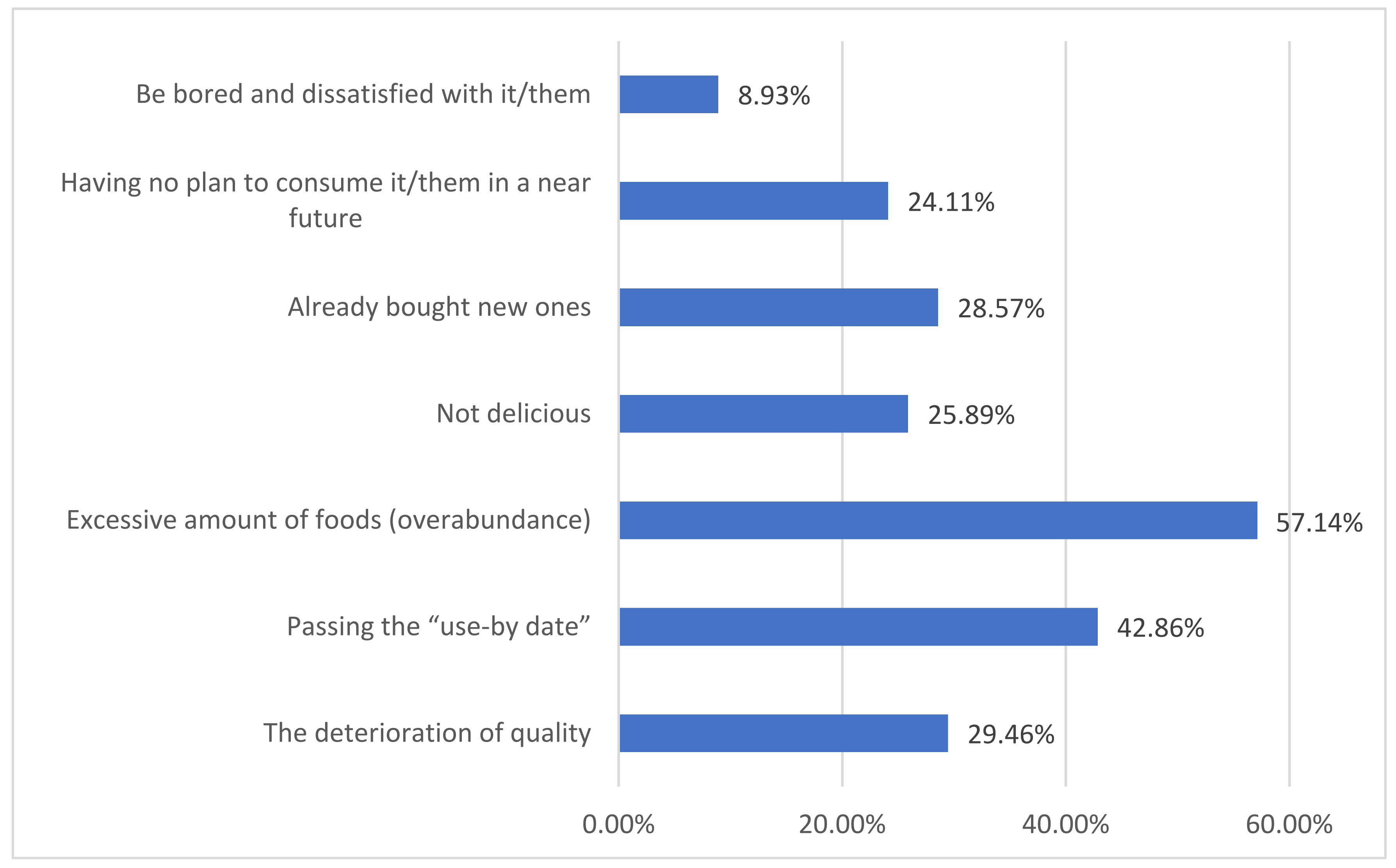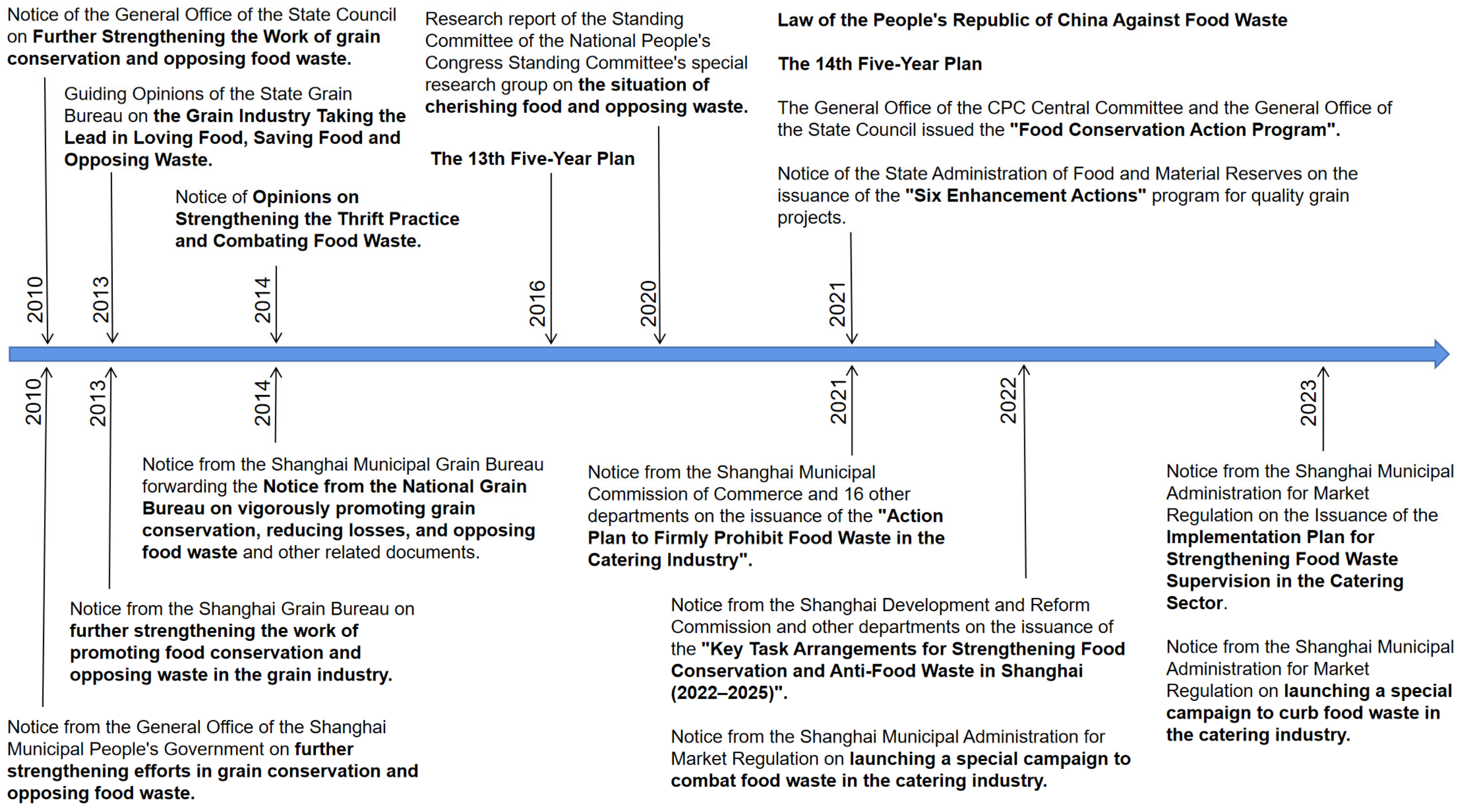Exploring Household Food Waste Reduction for Carbon Footprint Mitigation: A Case Study in Shanghai, China
Abstract
:1. Introduction
2. Materials and Methods
2.1. Investigation of Food Waste Generation
2.1.1. Sampling Size and Analytical Methodology
2.1.2. Content of Questionnaire
2.2. Carbon Footprint Measurement
2.2.1. System Boundaries
2.2.2. Carbon Footprint Calculation Methods and Data Sources
- 1.
- Raw material production stage:
- 2.
- Transportation stage:
- 3.
- Food preparation stage:
- 4.
- Waste disposal stage:
- 1.
- Raw material production stage
- 2.
- Transportation stage
- 3.
- Food preparation stage
- 4.
- Waste disposal stage
2.3. Cronbach’s α Reliability Coefficient Analysis
2.4. Logistic Regression Analysis
3. Results
3.1. Food Waste Carbon Footprint
3.1.1. Amount of Food Waste Generated by Shanghai Residents
3.1.2. Carbon Footprint of Edible Food Waste by Residents in Shanghai
3.2. The Factors Influencing Food Waste
3.2.1. The Internal Consistency of the Questionnaire
3.2.2. The Impact of Respondents’ Characteristics on Food Waste
3.2.3. Factors Influencing the High Frequency of Food Waste Generation
3.3. Policies concerning Food Waste
4. Discussion and Recommendations
4.1. Discussion
4.2. Recommendation
- 1.
- Improving ecological agricultural production models.
- 2.
- Adopting a centralized supply and local consumption approach is recommended.
- 3.
- Enhance waste sorting and resource utilization systems.
- 4.
- Raise residents’ awareness of energy conservation.
- 5.
- Raise consumer awareness of food purchasing and utilization.
- 6.
- Properly planning food storage.
- 7.
- Building a food donation platform.
5. Conclusions
Author Contributions
Funding
Data Availability Statement
Acknowledgments
Conflicts of Interest
References
- IEA. CO2 Emissions in 2022. Available online: https://www.iea.org/reports/co2-emissions-in-2022 (accessed on 29 June 2023).
- UN. State of the Climate. Available online: https://www.unep.org/explore-topics/climate-action/what-we-do/climate-action-note/state-of-climate.html?gclid=CjwKCAjwv8qkBhAnEiwAkY-ahpK28V5M5USfrpdwEBMFBLEYJwvSKb-WDmyNlt1Ha3WdRLiocZpvGBoC-ywQAvD_BwE (accessed on 22 June 2023).
- UN. UNEP Food Waste Index Report. 2021. Available online: https://www.unep.org/resources/report/unep-food-waste-index-report-2021 (accessed on 30 June 2023).
- Zhang, P.P.; Bai, J.F.; Liu, X.J.; Cheng, S.K. Food waste at the consumer end: Impact and action. J. Nat. Resour. 2019, 34, 437–450. [Google Scholar]
- Roodhuyzen, D.M.A.; Luning, P.A.; Fogliano, V.; Steenbekkers, L.P.A. Putting together the puzzle of consumer food waste: Towards an integral perspective. Trends Food Sci. Technol. 2017, 68, 37–50. [Google Scholar]
- UN. Stop Food Loss and Waste, for the People, for the Planet. Available online: https://www.un.org/en/observances/end-food-waste-day (accessed on 29 June 2023).
- Xue, L.; Liu, X.; Lu, S.; Cheng, G.; Hu, Y.; Liu, J.; Dou, Z.; Cheng, S.; Liu, G. China’s food loss and waste embodies increasing environmental impacts. Nat. Food 2021, 2, 519–528. [Google Scholar] [PubMed]
- Zhang, D.; Lun, F.; Cheng, S.K.; Gao, L.W.; Liu, X.J.; Cao, X.C.; Qin, Q.; Liu, Y.; Bai, J.F.; Xu, S.W.; et al. Phosphorus footprint of urban food waste and its environmental emissions: The case of Beijing. J. Nat. Resour. 2016, 31, 812–821. [Google Scholar]
- Sha’ari, N.S.M.; Sazali, U.S.; Zolkipli, A.T.; Vargas, R.Q.; Shafie, F.A. Environmental assessment of casual dining restaurants in urban and suburban areas of peninsular Malaysia during the COVID-19 pandemic. Environ. Monit. Assess. 2023, 195, 346. [Google Scholar]
- Matzembacher, D.E.; Brancoli, P.; Maia, L.M.; Eriksson, M. Consumer’s food waste in different restaurants configuration: A comparison between different levels of incentive and interaction. Waste Manag. 2020, 115, 263–273. [Google Scholar]
- Zhu, Q.; Li, F.; Qian, Z. A study on the waste profile of canteen food and its take-away carbon footprint in universities nationwide—A survey based on 9660 questionnaires from 30 universities in 30 provinces (cities). Resour. Environ. Arid Reg. 2020, 34, 49–55. [Google Scholar]
- Martinho, N.; Cheng, L.; Bentes, I.; Teixeira, C.A.; Silva, S.S.; Martins, M.L. Environmental, Economic, and Nutritional Impact of Food Waste in a Portuguese University Canteen. Sustainability 2022, 14, 15608. [Google Scholar]
- Qian, L.; Rao, Q.L.; Liu, H.B.; McCarthy, B.; Liu, L.X.; Wang, L.E. Food waste and associated carbon footprint: Evidence from Chinese universities. Ecosyst. Health Sustain. 2022, 8, 2130094. [Google Scholar]
- Gooch, M.; Matsubuchi-Shaw, M.; Bucknell, D.; LaPlain, D.; Kohler, L. Quantifying the carbon footprint of household food waste and associated GHGs in Oakville, Ontario, and a municipality’s role in reducing both food waste and GHGs. Can. Geogr./Geogr. Can. 2022, 66, 769–782. [Google Scholar]
- Adelodun, B.; Kim, S.H.; Odey, G.; Choi, K.S. Assessment of environmental and economic aspects of household food waste using a new Environmental-Economic Footprint (EN-EC) index: A case study of Daegu, South Korea. Sci. Total Environ. 2021, 776, 146928. [Google Scholar]
- Song, G.B.; Li, M.J.; Semakula, H.M.; Zhang, S.S. Food consumption and waste and the embedded carbon, water and ecological footprints of households in China. Sci. Total Environ. 2015, 529, 191–197. [Google Scholar]
- Thapa, P.; Hasnine, M.T.; Zoungrana, A.; Thakur, S.; Yuan, Q.Y. Food Waste Treatments and the Impact of Composting on Carbon Footprint in Canada. Fermentation 2022, 8, 566. [Google Scholar]
- Bhatia, L.; Jha, H.; Sarkar, T.; Sarangi, T.K. Food Waste Utilization for Reducing Carbon Footprints towards Sustainable and Cleaner Environment: A Review. Int. J. Environ. Res. Public Health 2023, 20, 2318. [Google Scholar] [PubMed]
- Cheng, S.J.; Song, G.B.; Yang, D.; Jiang, Z.; Zhao, M. Spatial-temporal and structural differences in the carbon footprints embedded in households food waste in urban and rural China. Environ. Sci. Pollut. Res. 2023, 20, 35009–35022. [Google Scholar]
- Lăzăroiu, G.; Valaskova, K.; Nica, E.; Durana, P.; Kral, P.; Bartoš, P.; Maroušková, A. Techno-Economic Assessment: Food Emulsion Waste Management. Energies 2020, 13, 4922. [Google Scholar]
- Lăzăroiu, G.; Andronie, M.; Uţă, C.; Hurloiu, I. Trust Management in Organic Agriculture: Sustainable Consumption Behavior, Environmentally Conscious Purchase Intention, and Healthy Food Choices. Front. Public Health 2019, 7, 340. [Google Scholar]
- Pocol, C.B.; Amuza, A.; Moldovan, M.G.; Stanca, L.; Dabija, D.C. Clustering food wasters on an emerging market: A national wide representative research. Foods 2023, 12, 1973. [Google Scholar]
- Tyagi, R.; Agrawal, A.; Ali, S.S. Indian Renewable Energy Act 2015: A Step towards Reducing Carbon Footprint. Indian J. Power River Val. Dev. 2020, 68, 145–151. [Google Scholar]
- Kish, L. Survey Sampling. Biom. J. 1965, 10, 88–89. [Google Scholar]
- NBS (National Bureau of Statistics). Major Figures on 2020 Population Census of China. Available online: http://www.stats.gov.cn/sj/pcsj/rkpc/d7c/202111/P020211126523667366751.pdf (accessed on 22 August 2023).
- Li, L.M. Study on the method of sample size allocation under stratified sampling. Stat. Decis. Mak. 2015, 19, 18–20. [Google Scholar]
- Chereji, A.I.; Chiurciu, I.A.; Popa, A.; Chereji, I.; Iorga, A.M. Consumer Behaviour Regarding Food Waste in Romania, Rural versus Urban. Agronomy 2023, 13, 571. [Google Scholar]
- Gonzalez-Santana, R.A.; Blesa, J.; Frigola, A.; Esteve, M.J. Dimensions of household food waste focused on family and consumers. Crit. Rev. Food Sci. Nutr. 2022, 62, 2342–2354. [Google Scholar]
- Liu, C.; Shang, J.; Liu, C.; Wang, H.; Wang, S.Y. Policy Recommendations for Reducing Food Waste: An Analysis Based on a Survey of Urban and Rural Household Food Waste in Harbin, China. Sustainability 2023, 15, 11122. [Google Scholar]
- Nguyen, T.; van den Berg, M.; Nguyen, M. Food waste in primary schools: Evidence from peri-urban Viet Nam. Appetite 2023, 183, 106485. [Google Scholar]
- Barrera, E.L.; Hertel, T. Global food waste across the income spectrum: Implications for food prices, production and resource use. Food Policy 2021, 98, 101874. [Google Scholar]
- Filipova, A.; Mokrejsova, V.; Sulc, Z.; Zeman, J. Characteristics of food-wasting consumers in the Czech Republic. Int. J. Consum. Stud. 2017, 41, 714–722. [Google Scholar]
- Zhang, M.R.; Chen, S.; Li, S.M. Life Cycle-Based Case Study of Greenhouse Gas Emissions and Emission Reduction from Food Consumption in Beijing Flavor Restaurants. Adv. Clim. Chang. Res. 2021, 17, 140–150. [Google Scholar]
- Wang, L.N.; Cheng, S.K.; Zhong, L.S.; Liu, X.J.; Gao, L.W.; Cao, X.C. Quantitative accounting of food consumption and its resource and environmental costs in the restaurant industry of tourist cities–the case of Lhasa city. J. Nat. Resour. 2016, 31, 215–227. [Google Scholar]
- Morooka, H.; Yamamoto, T.; Tanaka, A.; Furuhashi, K.; Miyagawa, Y.; Maruyama, S. Influence of COVID-19 on the 10-year carbon footprint of the Nagoya University Hospital and medical research centre. Glob. Health 2022, 18, 92. [Google Scholar] [CrossRef]
- Wang, W.; Lin, J.N.; Cui, S.H.; Lin, T. An Overview of Carbon Footprint Analysis. Environ. Sci. Technol. 2010, 33, 71–78. [Google Scholar]
- Ma, H.B.; Zhu, Q. Carbon Footprint Analysis of Night Market Chicken Fillets under Carbon Neutral Target. Resour. Environ. Arid Reg. 2022, 36, 41–47. [Google Scholar]
- Zhu, Q.; Ma, H.B.; Ao, X.Y.; Yan, F.F. A study on carbon footprint estimation of food waste in high school canteens. J. Shanxi Agric. Univ. (Soc. Sci. Ed.) 2022, 21, 90–98. [Google Scholar]
- Meisterling, K.; Samaras, C.; Schweize, R.V. Decisions to reduce greenhouse gases from agriculture and product transport: LCA case study of organic and conventional wheat. J. Clean. Prod. 2009, 17, 222–230. [Google Scholar]
- Zhu, M.X.; Luo, Y.; Huang, H.Q.; Huang, D.; Wu, L.P. Characteristics, environmental impacts and countermeasures of food waste in Chinese rural households. Agric. Mod. Res. 2022, 43, 948–956. [Google Scholar]
- Anagnostopoulos, K.; Kalogeropoulos, N.; Costarelli, V. Estimated Carbon Dioxide Equivalents Emissions in Greece, Following Different Types of Diet; Haprokopio University, Department of Home Economic & Ecology: Athens, Greece, 2014. [Google Scholar]
- Qu, Z.W.; Jin, M.M. Research on carbon footprint assessment of Anji white tea based on “two mountains” concept. Hubei Agric. Sci. 2022, 61, 53–56+88. [Google Scholar]
- Noponen, M.R.A.; Edwards-Jones, G.; Haggar, J.P.; Soto, G.; Attarzadeh, N.; Healey, J.R. Greenhouse gas emissions in coffee grown with differing input levels under conventional and organic management. Agric. Ecosyst. Environ. 2012, 151, 6–15. [Google Scholar]
- Zhang, Z.H.; Wan, X.T.; Yan, X.; Pan, S.Y.; Zhang, L.J.; Guo, W.J. Carbon footprint analysis of typical beverage coffee based on LCA theory. Agric. Technol. 2023, 43, 71–75. [Google Scholar]
- Wu, Y.; Wang, X.K.; Lu, F. The carbon footprint of food consumption in Beijing. Acta Ecol. Sin. 2012, 32, 1570–1577. [Google Scholar]
- Zhou, H.Q. Analysis of the Current Situation and Countermeasures of the Utilization of Wet Waste in Shanghai. Shanghai Constr. Sci. Technol. 2022, 2, 80–82+86. [Google Scholar]
- Zhou, C. Study on the Driving Factors of Carbon Emission Changes in Shanghai Municipal Waste Treatment. Energy Environ. 2023, 3, 25–27+44. [Google Scholar]
- Shanghai Municipal Bureau of Ecology and Environment. Shanghai Solid Waste Pollution Prevention and Control Information Announcement in 2022. Available online: https://sthj.sh.gov.cn/hbzhywpt1103/hbzhywpt1112/20230619/a42027b46763442197e81392313fb5c0.html (accessed on 17 August 2023).
- China Building Energy Efficiency Association; Institute of Urban and Rural Construction and Development, Chongqing University. 2022 Research Report on Carbon Emissions from Municipal Domestic Waste Treatment in China. Urban Rural Constr. 2023, 8, 72–79. [Google Scholar]
- Tian, X.Y.; Zheng, C.J.; Guo, S.Y.; He, G.R. Evaluating Test Reliability: From Coefficient Alpha to Internal Consistency Reliability. New Psychol. 2019, 39, 461–467. [Google Scholar]
- Lu, S. Research on influencing factors of rural revitalization based on binary logistic regression model: Perspective of grassroots cadres’ confidence. J. Contemp. Econ. 2002, 39, 106–110. [Google Scholar]
- Sun, R. Survey on residents’ willingness to delay retirement mode based on logistic regression—Taking Chongqing Municipality as an example. Res. World 2018, 12, 14–18. [Google Scholar]
- Shanghai Bureau of Statistics. Shanghai Statistical Yearbook. 2022. Available online: https://tjj.sh.gov.cn/tjnj/20230206/804acea250d44d2187f2e37d2e5d36ba.html (accessed on 4 July 2023).
- Shanghai Greening and Amenities Administration. The Third Anniversary of the Implementation of the Shanghai Municipal Domestic Waste Management Regulations. Available online: https://lhsr.sh.gov.cn/ywdt/20220704/91d70fe7-9a68-4baf-bcd8-222f667e507d.html (accessed on 4 July 2023).
- Holcomb, W.L.J.; Chaiworapongsa, T.; Luke, D.A.; Burgdorf, K.D. An odd measure of risk: Use and misuse of the odds ratio. Obstet. Gynecol. 2001, 98, 685–688. [Google Scholar] [CrossRef]
- Katz, K.A. The (relative) risks of using odds ratios. Arch. Dermatol. 2006, 142, 761–764. [Google Scholar] [CrossRef]
- Wooldridge, J.M. Introductory Econometrics: A Modern Approach, 6th ed.; Cengage Learning: Boston, MA, USA, 2016. [Google Scholar]
- Peking University Legal Information Platform. Notice of the General Office of the State Council on Further Strengthening the Work of Grain Conservation and Opposing Food Waste. Available online: https://www.pkulaw.com/chl/c1fb03dbead034a1bdfb.html (accessed on 25 July 2023).
- Peking University Legal Information Platform. Notice from the General Office of the Shanghai Municipal People’s Government on Further Strengthening Efforts in Grain Conservation and Opposing Food Waste. Available online: https://www.pkulaw.com/lar/0bdb5d07938a8f943424996ff50acc90bdfb.html (accessed on 25 July 2023).
- Peking University Legal Information Platform. Guiding Opinions of the State Grain Bureau on the Grain Industry Taking the Lead in Loving Food, Saving Food and Opposing Waste. Available online: https://www.pkulaw.com/chl/4f8b1d0fd543f83fbdfb.html (accessed on 25 July 2023).
- Peking University Legal Information Platform. Notice from the Shanghai Grain Bureau on Further Strengthening the Work of Promoting Food Conservation and Opposing Waste in the Grain Industry. Available online: https://www.pkulaw.com/lar/ba055238b190d886573ae4d1049b3d0dbdfb.html (accessed on 25 July 2023).
- Peking University Legal Information Platform. The General Office of the Communist Party of China Central Committee and the General Office of the State Council Issued the “Opinions on Practicing Frugality and Opposing Food Waste”. Available online: https://www.pkulaw.com/chl/93e666fb03f5e10bbdfb.html (accessed on 25 July 2023).
- Peking University Legal Information Platform. Notice from the Shanghai Municipal Grain Bureau Forwarding the “Notice from the National Grain Bureau on Vigorously Promoting Grain Conservation, Reducing Losses, and Opposing Food Waste” and Other Related Documents. Available online: https://www.pkulaw.com/lar/02c1044dcb44845d51c80e83f0b3bcc2bdfb.html (accessed on 25 July 2023).
- Peking University Legal Information Platform. People’s Republic of China Anti-Food Waste Law. Available online: https://www.pkulaw.com/chl/97d7d0ae995676c1bdfb.html (accessed on 25 July 2023).
- Peking University Legal Information Platform. Notice from the Shanghai Municipal Administration for Market Regulation on the Issuance of the “Implementation Plan for Strengthening Food Waste Supervision in the Catering Sector”. Available online: https://www.pkulaw.com/lar/882799692c19e5c6f72b5637a2403864bdfb.html (accessed on 25 July 2023).
- Peking University Legal Information Platform. Notice from the Shanghai Municipal Administration for Market Regulation on Launching a Special Campaign to Curb Food Waste in the Catering Industry. Available online: https://www.pkulaw.com/lar/4a3fdcdd648e279972da0c29d3d3abbebdfb.html (accessed on 25 July 2023).
- Cakar, B.; Aydin, S.; Varank, G.; Ozcan, H.K. Assessment of environmental impact of FOOD waste in Turkey. J. Clean. Prod. 2020, 244, 118846. [Google Scholar]
- Zhang, D.; Cheng, S.K.; Gao, L.W.; Liu, X.J.; Cao, X.C.; Liu, Y.; Bai, J.F.; Xu, S.W.; Yu, W.; Qin, Q. The carbon footprint of catering industry food waste: A Beijing case study. Acta Ecol. Sin. 2016, 36, 5937–5948. [Google Scholar]
- Gorny, K.; Idaszewska, N.; Sydow, Z.; Bienczak, K. Modelling the Carbon Footprint of Various Fruit and Vegetable Products Based on a Company’s Internal Transport Data. Sustainability 2021, 13, 7579. [Google Scholar] [CrossRef]
- Goldstein, B.; Birkved, M.; Fernandez, J.; Hauschild, M. Surveying the Environmental Footprint of Urban Food Consumption. J. Ind. Ecol. 2017, 21, 151–165. [Google Scholar]
- Jiang, J.Q.; Yu, T.E.; Huan, W.Z.; Wang, Z. Size estimation and determinants analysis of household food waste in China. Agric. Technol. Econ. 2018, 9, 88–99. [Google Scholar]
- Liao, F. A study of the factors influencing food waste behavior based on an extended MOA mode. J. Shanxi Agric. Univ. (Soc. Sci. Ed.) 2022, 21, 99–108. [Google Scholar]
- Zhang, H.; Duan, H.; Andric, J.M.; Song, M.; Yang, B. Characterization of household food waste and strategies for its reduction: A Shenzhen City case study. Waste Manag. 2018, 78, 426–433. [Google Scholar] [PubMed]
- Sujauddin, M.; Huda, S.M.S.; Hoque, A.T.M.R. Household solid waste characteristics and management in Chittagong, Bangladesh. Waste Manag. 2008, 28, 1688–1695. [Google Scholar] [CrossRef] [PubMed]
- Stancu, V.; Haugaard, P.; Lhteenmki, L. Determinants of consumer food waste behaviour: Two routes to food waste. Appetite 2016, 96, 7–17. [Google Scholar]
- Ganglbauer, E.; Fitzpatrick, G.; Comber, R. Negotiating food waste: Using a practice lens to inform design. Assoc. Comput. Mach. J. 2013, 20, 1–25. [Google Scholar]
- Visschers, V.H.M.; Wickli, N.; Siegrist, M. Sorting out food waste behaviour: A survey on the motivators and barriers of self-reported amounts of food waste in households. J. Environ. Psychol. 2016, 45, 66–78. [Google Scholar]




| Project | Carbon Emission Coefficient | Unit |
|---|---|---|
| Leftover of cooked staple food | 0.937 | kgCO2eq/kg |
| Leftover of cooked dishes | 2.516 | kgCO2eq/kg |
| Untouched food | 2.809 | kgCO2eq/kg |
| Project | Carbon Emission Coefficient | Unit |
|---|---|---|
| Diesel | 1.9 | kgCO2eq/kg |
| Project | Carbon Emission Coefficient | Unit |
|---|---|---|
| Water | 0.193 | kgCO2eq/kg |
| Electricity | 0.612 | kgCO2eq/kg |
| Natural gas | 1.881 | kgCO2eq/kg |
| Project | Staple Food | Dishes |
|---|---|---|
| Carbon Emission Coefficient (kgCO2eq/kg) | 0.836 | 0.38 |
| Project | Carbon Emission Coefficient | Unit |
|---|---|---|
| Wet Waste Resource Utilization | 0.24 | kgCO2eq/kg |
| Cronbach’s α Range | Reliability Interpretation |
|---|---|
| 0.90 and above | Excellent reliability |
| 0.80 to 0.89 | Good reliability |
| 0.70 to 0.79 | Acceptable reliability |
| 0.60 to 0.69 | Questionable reliability |
| 0.50 to 0.59 | Poor reliability |
| Below 0.50 | Very poor reliability |
| Variable Name | Definition and Allocation of Variables | Mean | Standard Deviation |
|---|---|---|---|
| Food waste (Y) | High frequency = 1, | 0.24 | 0.43 |
| Low frequency = 0 | |||
| Area (X1) | Urban areas = 1, | 0.92 | 0.28 |
| Surrounding areas = 0 | |||
| Gender (X2) | Male = 1, | 0.51 | 0.50 |
| Female = 0 | |||
| Age (X3) | ≤30 = 1, | 1.79 | 0.82 |
| 31–40 = 2, | |||
| 41–50 = 3, | |||
| 51–60 = 4, | |||
| >60 = 5 | |||
| Education level (X4) | No formal education = 1, | 6.29 | 1.19 |
| Elementary school = 2, | |||
| Junior high school = 3, | |||
| Technical school = 4, | |||
| Senior high school = 5, | |||
| Vocational or Technical University = 6, | |||
| University = 7, | |||
| Master’s Degree or Higher = 8 | |||
| Annual household income (X5) | Up to CNY 30,000 = 1, | 3.77 | 1.30 |
| CNY 30,001–80,000 = 2, | |||
| CNY 80,001–150,000 = 3, | |||
| CNY 150,001–300,000 = 4, | |||
| CNY 300,001–1 million = 5, | |||
| CNY 1–5 million = 6, | |||
| Over CNY 5 million = 7 |
| Project | Amount of Food Waste Generated per Capita per Day (g) | Annual per Capita Food Waste (kg) | Daily Food Waste Generated (104t) | Annual Food Waste (104t) |
|---|---|---|---|---|
| Cooking waste | 297.30 | 108.51 | 0.74 | 268.57 |
| Leftover of cooked staple food | 50.43 | 18.41 | 0.12 | 45.56 |
| Leftover of cooked dishes | 106.63 | 38.92 | 0.26 | 96.33 |
| Untouched food | 88.67 | 32.37 | 0.22 | 80.11 |
| Tea leaves and coffee grounds | 22.97 | 8.39 | 0.06 | 20.75 |
| Total | 566.00 | 206.59 | 1.40 | 511.32 |
| Project | Annual Food Waste (104t) | Carbon Footprint for the Raw Material Production Stage (104tCO2eq) | Carbon Footprint for the Transportation Stage (104tCO2eq) | Carbon Footprint for the Food Preparation Stage (104tCO2eq) | Carbon Footprint for the Food Waste Disposal Stage (104tCO2eq) |
|---|---|---|---|---|---|
| Leftover of cooked staple food | 45.56 | 42.69 | 86.56 | 38.09 | 10.93 |
| Leftover of cooked dishes | 96.33 | 242.37 | 183.03 | 36.61 | 23.12 |
| Untouched food | 80.11 | 225.03 | 152.21 | 0 | 19.23 |
| Total | 222 | 510.09 | 421.8 | 74.7 | 53.28 |
| The annual carbon footprint of food waste | 1059.87 (104tCO2eq) | ||||
| Per Capita Daily Carbon Footprint of Food Waste (kgCO2eq) | Per Capita Annual Carbon Footprint of Food Waste (kgCO2eq) | Daily Carbon Footprint of Food Waste Generated (104tCO2eq) | Annual Carbon Footprint of Food Waste (104tCO2eq) |
|---|---|---|---|
| 1.17 | 428.23 | 2.90 | 1059.87 |
| Cronbach’s α | Number of Items |
|---|---|
| 0.7855 | 7 |
| Characteristics | Number of Respondents | Percentage |
|---|---|---|
| Area: | ||
| Urban areas | 422 | 91.54% |
| Rural areas | 39 | 8.46% |
| Gender: | ||
| Male | 236 | 51.19% |
| Female | 225 | 48.81% |
| Age: | ||
| ≤30 | 199 | 43.17% |
| 31–40 | 173 | 37.53% |
| 41–50 | 79 | 17.14% |
| 51–60 | 8 | 1.74% |
| >60 | 2 | 0.43% |
| Education level | ||
| No formal education | 0 | 0 |
| Elementary school | 4 | 0.87% |
| Junior high school | 21 | 4.56% |
| Technical school | 12 | 2.60% |
| Senior high School | 21 | 4.56% |
| Vocational or Technical University | 197 | 42.73% |
| University | 153 | 33.19% |
| Master’s Degree or Higher | 53 | 11.50% |
| Annual household income | ||
| Up to CNY 30,000 | 23 | 4.99% |
| CNY 30,001–80,000 | 62 | 13.45% |
| CNY 80,001–150,000 | 77 | 16.70% |
| CNY 150,001–300,000 | 176 | 38.18% |
| CNY 300,001–1 million | 88 | 19.09% |
| CNY 1–5 million | 27 | 5.86% |
| Over CNY 5 million | 8 | 1.74% |
| Odds Ratio | Standard Error | z | p > |z| | (95% Conf. Interval) | ||
|---|---|---|---|---|---|---|
| X1 | 0.715 | 0.282 | −0.85 | 0.396 | 0.330 | 1.551 |
| X2 | 1.443 | 0.326 | 1.62 | 0.105 | 0.926 | 2.248 |
| X3 | 0.876 | 0.126 | −0.92 | 0.360 | 0.661 | 1.162 |
| X4 | 1.310 | 0.152 | 2.33 | 0.020 * | 1.044 | 1.643 |
| X5 | 1.375 | 0.128 | 3.42 | 0.001 ** | 1.146 | 1.650 |
Disclaimer/Publisher’s Note: The statements, opinions and data contained in all publications are solely those of the individual author(s) and contributor(s) and not of MDPI and/or the editor(s). MDPI and/or the editor(s) disclaim responsibility for any injury to people or property resulting from any ideas, methods, instructions or products referred to in the content. |
© 2023 by the authors. Licensee MDPI, Basel, Switzerland. This article is an open access article distributed under the terms and conditions of the Creative Commons Attribution (CC BY) license (https://creativecommons.org/licenses/by/4.0/).
Share and Cite
Liu, C.; Shang, J.; Liu, C. Exploring Household Food Waste Reduction for Carbon Footprint Mitigation: A Case Study in Shanghai, China. Foods 2023, 12, 3211. https://doi.org/10.3390/foods12173211
Liu C, Shang J, Liu C. Exploring Household Food Waste Reduction for Carbon Footprint Mitigation: A Case Study in Shanghai, China. Foods. 2023; 12(17):3211. https://doi.org/10.3390/foods12173211
Chicago/Turabian StyleLiu, Chang, Jie Shang, and Chen Liu. 2023. "Exploring Household Food Waste Reduction for Carbon Footprint Mitigation: A Case Study in Shanghai, China" Foods 12, no. 17: 3211. https://doi.org/10.3390/foods12173211
APA StyleLiu, C., Shang, J., & Liu, C. (2023). Exploring Household Food Waste Reduction for Carbon Footprint Mitigation: A Case Study in Shanghai, China. Foods, 12(17), 3211. https://doi.org/10.3390/foods12173211








